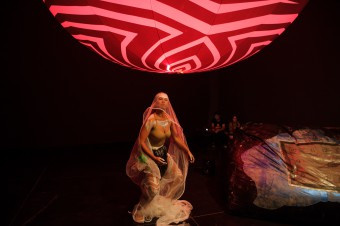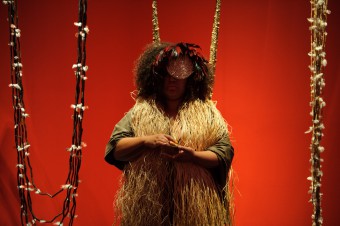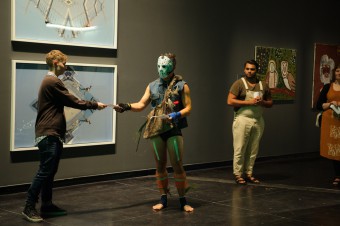In the dim, blue-black lighting of the foyer at ACCA, a sea of people turn to the centre as the metallic walls around them echo a heavy bass. Heads shuffle between shoulders trying to get a better look at what is coming. What we see first is a moving head-dress: bush flowers and leaves blooming into a crown that is shifting through the shadows of the crowd. A tall figure veiled in black can be spotted moving nearby, heaving beneath a thick boa of red hibiscus. We start to see more of the performers now: a painted forehead trailing in a white net; an eye patch visible above a body of voluminous raffia; naked breasts below a face of markings. The audience looks around, trying to understand what is happening as the figures move closer, seemingly growing in numbers. They are stoic and defiant in the dark ambience of the surrounds.
Lukautim Solwara (look out for the ocean) is the highly anticipated new work instigated by the critically acclaimed performance artist, Rosanna Raymond (SAM/NZ). Presented in Melbourne by Nextwave as part of AsiaTOPA, the immersive performance installation sees eight First Nations artists from Maori, Pacific Indigenous and Aboriginal heritage, inhabit the gallery space of the Australian Centre for Contemporary Art. The intention is to activate and interact with the works of the Sovereignty exhibition currently showing there using various mediums of performance. Lukautim Solwara – meaning ‘to look out for’ or, ‘look after the ocean’ – also draws attention to the impacts of climate change on the Pacific Islands and its peoples. Interweaving these issues, the work highlights the ongoing resilience of First Nations peoples in New Zealand, Australia and the Pacific Islands, despite historical and contemporary persecution, and now, environmental degradation.

For context, the Pacific Islands are among the worst affected by the impacts of climate change. Agricultural, coastal and ecosystem impacts have had severe impacts on food and resources, and rising sea-levels have already claimed five small islands. At the same time, neighbouring Australia – the highest coal consumer per capita in the world – has dismantled its existing carbon reduction strategies, scrapped its climate change institutions, and cut over 110 climate scientist positions from the national science body. Whilst political rhetoric trivializes this situation, people in places such as the Pacific Islands are caught in between.
Intersecting this issue, the work also considers the historical and contemporary narratives of First Nations peoples. By interacting with the themes of the Sovereignty exhibition, Lukautim Solwara references the manifold implications and symbolisms of the artworks in the exhibition. It speaks to the persistence of Aboriginal culture in a contemporary environment, whilst acknowledging a historical denial of physical, cultural and spiritual rights. For the audience, witnessing the bodies of the artists dressed in debris-laden attire alongside these meaningful artifacts creates a liminal space. The characters simultaneously became survivors returning from a dystopian future, and ancient forebearers visiting from the past.
The multi-faceted nature of the work no doubt reflects a confluence of disciplines practices by its creators. An internationally renowned performer, curator, poet, and Honorary Research Associate in Anthropology (University College, London), Raymond has carved out a name in the contemporary art world with her raw and confronting multi-disciplinary explorations of contemporary Pacific Islander culture. Most recently in 2016, her installation SaVAge K’lub at the eighth Asia Pacific Triennial of Contemporary Art in Queensland won wide accolades. In Lukautim Solwara, we see the trademark of her aesthetic: body adornments that punctuate the recognisable imagery of indigenous Pacific Islander culture with the largesse of contemporary avant-garde haute couture.

Alongside Raymond, Lukautim Solwara was developed with seven other celebrated artists of First Nations heritage from New Zealand, Australia and the Pacific Islands. Namely, curator and visual artist Leuli Eshraghi (Samoa/Iran), multi-disciplinary artists Reina Sutton (Solomon Islands) and Jaimie Waititi (New Zealand Maori), dancer and choreographers Amrita Hepi (Ngapuhi NZ and Bundjalung) and Thomas ES Kelly (Bundjalung/Wiradjuri), and visual artists Nicole Monks (Yamatji Wajarri) and Steven Rhall (Taungurong).
The work was created over a two-week intensive development period which was run using the Maori idea of wānanga: a place to meet, deliberate, consider and learn. The Pacific and Indigenous collections of Melbourne Museum also informed the content, as did exploring the gallery space of ACCA, and running interactive workshops. A key focus of the creative process was the Samoan concept of vā, which regards space as active.
Each of the artists interpreted this concept through their own medium, bringing a unique aesthetic to their interventions. The result was an intense and provocative performative landscape that invited audience members into a space of contemplation. The focus of the viewer shifted between provocations of performance and subjective-interpretations of visual art throughout the duration of the work.
One way the artists approached their performance was by connecting their embodied narratives to the statements embedded in the works on exhibition, such as Hepi’s character, drowning in a plastic net as she crawled past the installation of Brook Andrew’s Maralinga Clock. Others employed stillness and presence as an adornment to the artwork, resurrecting their symbolism into form by an associative stance. This was particularly poignant in Raymond’s character dripping blood from her chest as she stood silently before Glenda Nicholls trinity of woven cloaks. Opposite her was the raffia-laden priest-like being of Sutton, standing beneath the necklaces of Marie Clark, offering blessings by marking the heads of passersby. At one point, a woman she marks is moved to tears, reflecting the intensity of the gesture and the fragile energy created in the space.

The intellectual aspects of the ideas in the artworks were also evoked through spoken word and interactive exercises that audience members were invited into. For example, a torn up Lisa Bellear photograph was handed out to bystanders by Rhall’s masked being; they were in turn invited to return them and piece it all back together, each trying to read the words and understand the fragmented historical message. In another room Kelly, dressed in the shreds of military combat performed a monologue before Marlene Gibson’s painting of Land lost, Land stolen, Treaty. “It will remain” he told us, before inviting the audience to mark his body.
Distinct from such interventions were pieces where the artists themselves became stand-alone performance works: Waititi’s character sombrely collected and removed plastic from her attire; a near-naked Eshraghi shredded coconut after coconut, continuing this task unperturbed throughout the duration of the work. In a similar vein, Monks’ character inhabited a self-created image nearby, sitting before a large vertical banner reading ‘Always Here’ in bold UV-lit pink. She sat stoic and unmoving as a large slab of ice melted at her feet.

The energy of these artists and the unique aesthetics of their mediums brought an exhilarating quality to the space. The atmosphere became an intense and ethereal paradigm merging past, present and future timelines. But the real success of Lukautim Solwara was in its ability to make audiences see the artwork of the Sovereignty exhibition in a new light. Where a work felt enlivened by the energy of the performance, the space felt tangibly activated and its impact was profound. In the aftermath of the occurrences, audience members were clearly drawn to contemplate the artworks before them more deeply.
While this work was specifically commissioned for the gallery space of ACCA, it perhaps would have had greater impact in a more intimate space. The narrow and vacuous rooms of the gallery’s interiors made it somewhat challenging to engage with the energy of the performers. It was easy to miss a happening on the other side of the gallery, and surely many audience members would have left thinking only two or three occurrences unfolded. At times the warmth and vibrancy of the performances was quickly cooled and the atmosphere felt diluted by by the vast emptiness of the large rooms.
It would have also been interesting to see greater interaction between the performers. While their characters were clear in their visual capacity and performative narratives, other dimensions of their personality were not revealed. Aside from the initial song sung in congregation to mark the beginning of the performance, they did not come together as a group. Where there was interaction, such as the anointment of Waititi’s debris-laden character by Raymond and Sutton, the audience was palpably excited. This is an aspect that surely holds greater explorations.

The performers did however connect to each other through call and response, which helped to create a sense of community between them. The sharp wails and piercing responses also acted as a response to the subject-matter, bringing urgency, mourning and defiance into the frame.
Importantly, Lukautim Solwara demonstrates new ways in which contemporary arts practice, indigenous arts, history and academia can meet in the space of immersive performance art. Works such as these create an opportunity for engagement with the contemporary identity of First Nations peoples, by First Nations peoples, and involve us in the conversation through a felt experience of their stories.
It is for such reasons that Lukautim Solwara is a much welcomed alternative to the offerings of Melbourne’s mainstream arts scene. An inquisitive and exciting work that opens up new possibilities in creative dialogue.
4 out of 5 stars.
Long-form critical content supported by Next Wave.
* Featured image: Rosanna Raymond, detail Lukautim Solwara. Photo: Sarah Walker.

